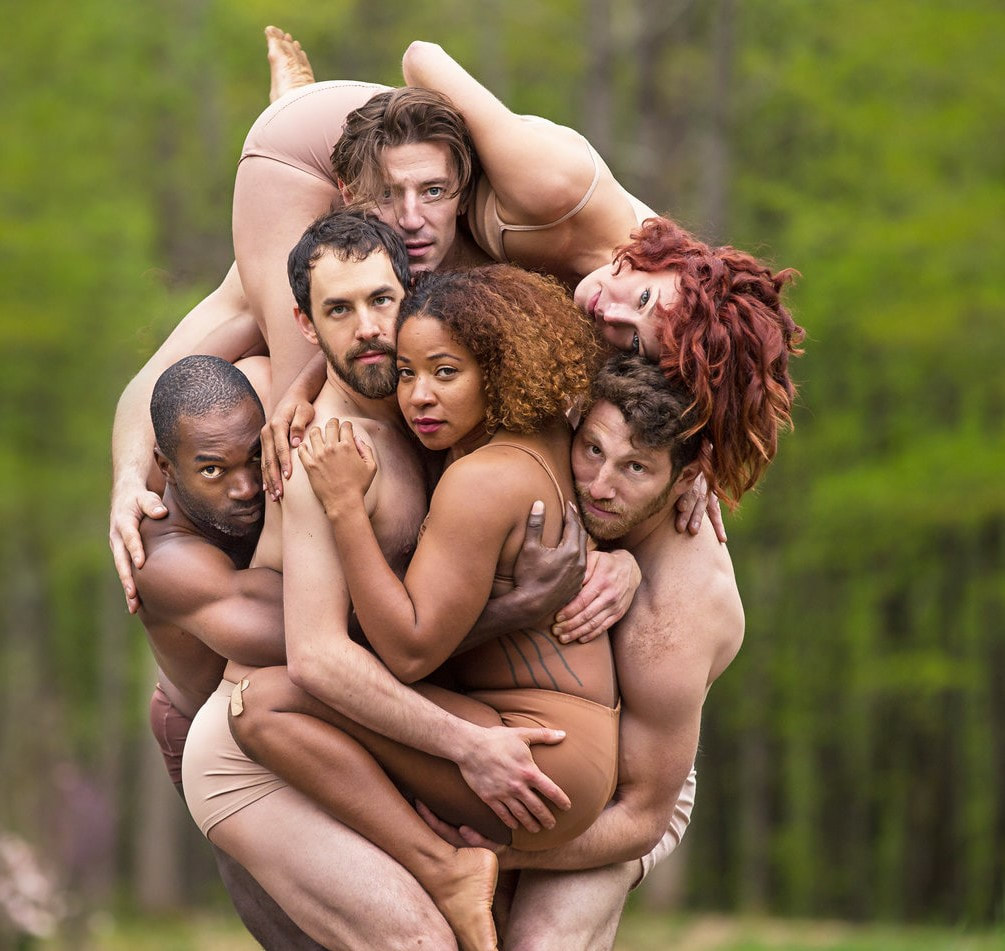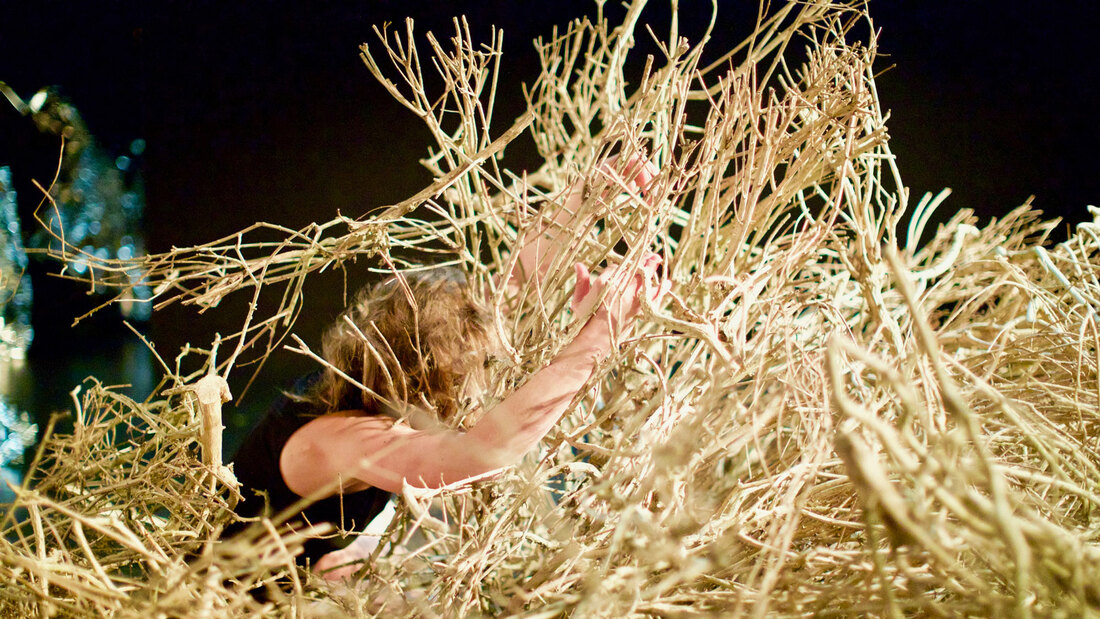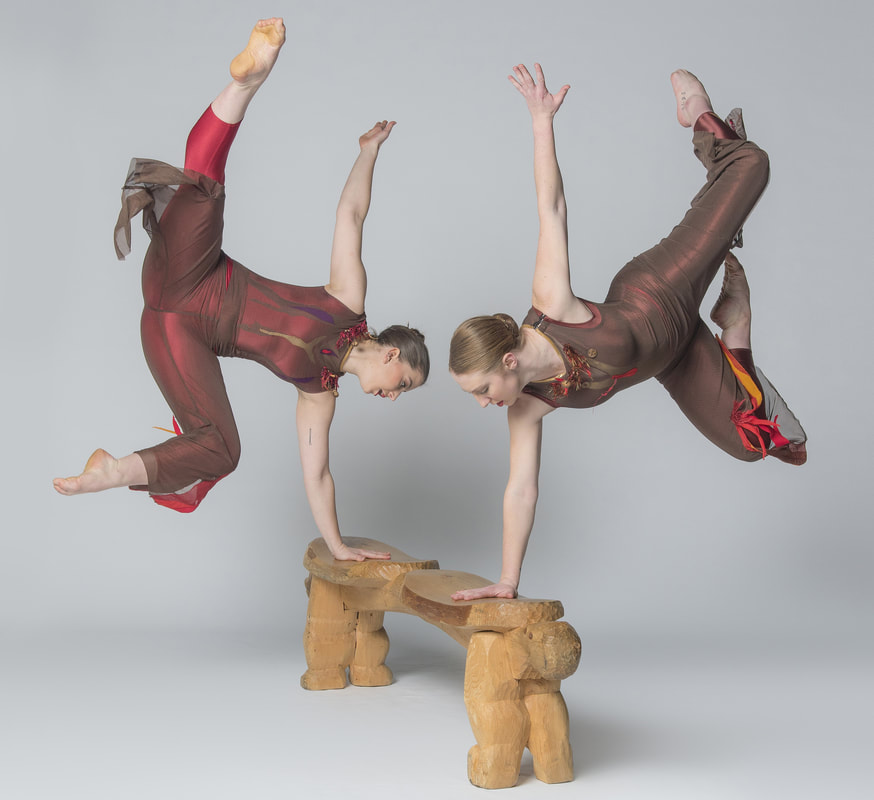|
Pilobolus Dance Company astonishes with clever physical feats. It’s been 48 years since a group of Dartmouth College students got together to form the Pilobolus Dance Company.
Not schooled in nor attached to the classical arts, the founders wowed the dance world with their ground-breaking works that settled on creating whimsical and comical illusions through astonishing and clever physical feats. Moreover, the works were not driven by one choreographer, but by the group. As the dance world has evolved and morphed into many different styles, Pilobolus is no longer unique. Yet the company still holds a grip on its avid fans who nearly filled The Egg on Saturday night. For this show, the company brought seven of its 16 dancers who presented a range of works – old and new. The program demonstrated that not all of the early works – the ones that sparked their fame – hold up today. “Untitled” from 1979 is among them. Krystal Butler and Heather Favretto ride the shoulder of Nathaniel Buchsbaum and Zachery Eisenstat who were hidden by their long gowns. Thus they appeared to be tall women experiencing a variety of scenario – including a stroll with suitors and giving birth. However, the sight gag didn’t outlast the piece. Yet one of the company’s first works from 1971, “Walklyndon” is enduring. This funny piece has six crossing the stage with silly gaits that lead to even sillier encounters. “Gnomen” and “Symbiosis,” from 1997 to 2001 respectively, are classic Pilobolus – graceful displays of acrobatic physical strength that hypnotize the viewer. The bodies in both of these dances – a quartet for men and then a duet for a man and woman – astonish with sculptural poses that transform again and again. The company finished out the program with a 2017 piece, “Branches,” in which the cast of six are birds – splashing in the water, settling in the trees and of course, flying. Created by the company’s current artistic directors Renee Jaworski and Matt Kent, it is a beautiful work that is not afraid to be literal with the gorgeous sound design by David Van Teighem. In between the choreographic gems, the company showed three short, intriguing videos. The best was “Magnifico,” a series of silhouettes of dancers forming themselves into collages of African animals and Greek urns. Like much of the show, it was magnifico.
0 Comments
Findlay//Sandmarks >>returner<< at EMPAC >>returner<<, as shown and developed at EMPAC, has its charms -- a dancer equipped with sensors that projects a distorted avatar on an ever-moving cube, a pile of amplified branches that echo with every snap and crunch of its fiber and an opening animated video short of “a man who shits and spits fire” and “a woman on fire” who is the rebellion that illuminates truth.
But while >>returner<<'s individual parts might be interesting, the piece by Findlay//Sandsmark doesn’t add up to a cohesive creation that resonates. The mysterious work has its hints of inspiration. For example, it was clever to lead the audience into a darkened room and then drop a curtain to reveal that we are the ones onstage. But aside from the surprise factor, the trick of perception and discomfort didn’t enhance the experience of >>returner<<. The artists should have just put us in theater seats as that’s where we ended up anyway. The piece from this Norwegian duo, director Iver Findlay and choreographer Marit Sandmark, was perhaps warning us about the world as an aberration. Technology is contorting humanity, leadership and the environment while the natural world is on fire -- climate change on steroids. The lighting design by Jean-Vincent Kerebel shimmered and twisted like tornados launching through the ceiling. Lights also swept along the floor, spinning thoughts of an insect parade, marching forward to devour the greenery. Sandmark, as the solo mover, flopped and flung her head and limbs. When the sensors were attached, her grotesque avatar looked to be swallowed by the wall – painfully sucked in as it tried to writhe free. Then when she finally took off the sensors her graphic figure crumbled into a heap, a mass of monstrous dysfunction. Throughout, and distractedly so, Nils Erga walked back and forth along a narrow corridor. At first I thought there was some kind of mistake, that Erga didn’t realize that we could see him, as the passage was off in the wings. Then I realized it was all part of this bizarre world. As it crumbles, humanity paces backs and forth, on the phone, without ever seeing the stark realities. Erga also was the work’s violinist, fiddling away to the ominous music that hummed loudly and then waned and rushed forth again. The video work by Victor Morales was well-done. But many of the passage were too long. Conversely, Sandmark’s interaction with the nature – rolling inside and atop the pile of sticks, was too short. >>returner<<, like most of what is presented at the Rensselaer venue, leaves the audience baffled. Would I recommend it? No. But I’m not thoroughly dissatisfied with the experience either. Ellen Sinopoli Dance Company in "From the Mind / of a single long vine / one hundred opening lives" (Photo by Gary Gold) Ellen Sinopoli Dance Company’s “From the mind / of a single long vine / one hundred opening lives” is a journey – one into a world that feels ancient, primal and one that tickles the imagination of those watching it unfold.
Presented on Friday night at The Egg, the dance based on a haiku poem dates back to 2001. And while the cast is smaller than its original, the evening length work emanates a new glow. Perhaps it’s the atmospheric lighting design by Stephanie Van Sandt, in which audiences can easily sense time lapses and moods shifts; or the costumes by Kim Vanyo that glimmer and flow. Certainly, much can be said for the synergistic spark that was ignited by choreographer Ellen Sinopoli and set designer Jim Lewis. (Think Martha Graham and Isamu Noguchi.) Lewis’ smooth wooden pieces that are as much props as they are sets, define the space and movement. Their look takes the viewer back to a time where nature, not manufactured molds and plastics, was the stuff life was made. Add that to the Sinopoli’s musical selections: Rokia Traore, Aisha Kahil, Ali Jihad Racy and Foday Musa Suso, among others, and one can’t help but feel steeped in an exotic, African-tinged world. The piece begins with the marvelous Laura Teeter as the sojourner. Swinging and pushing one of Lewis’ sculptures, like a suitcase, Teeter moves along like the jaunty traveler, daringly dipping her toe into the waters of a new land. As she departs, the "Caravan" moves in. Five enter and glide and slide along a bench. As they move forward, they people the world. As life in the land progresses, the audience watches love unfold, women at work, a child at play and destruction and death. Yet it circles back around to a land revived, life goes on for those willing to embrace it. There are several memorable sections to the dance. “The Betrothed” with Andre Robles and Sara Senecal is sweet, but not as seductive as it could be. Robles and Senecal play tentative lovers, perhaps a little overwhelmed of the prospects of marriage. In addition to the dance itself, the thing I liked about this duet on a bench was Robles himself. His confidence as a performer is growing. Yet he has yet to unleash his full power. Part of the problem may be that he’s trying to match the tone of an all-female ensemble. Sinopoli’s troupe needs more men to tease out Robles’ virile nature that he keeps, unfortunately, under wraps. But back to the dance’s indelible moments, which also include “Predators.” This explosive section is a battle against unseen forces that scatter and kill. The “Shrouded Soul,” in which they honor the dead, the casualties of war, is also encapsulated in the mind’s eye. It’s both dignified and heartbreaking. In the end, the community of “From the mind / of a single long vine / one hundred opening lives” is restored by literally locking together the pieces of a mysterious icon (another Lewis creations). With this, the sojourner moves on. But the audience doesn’t. The images resonate for some time. |
Wendy
|



 RSS Feed
RSS Feed
